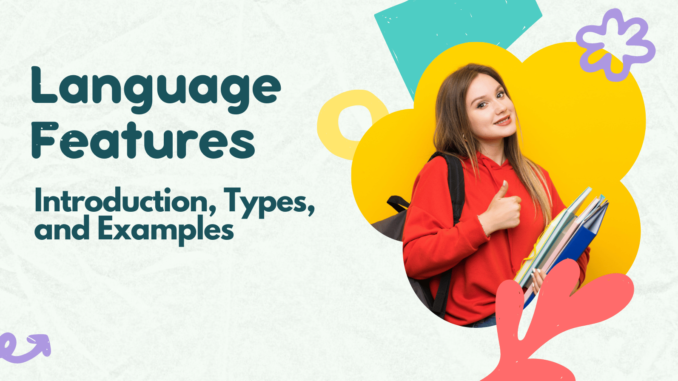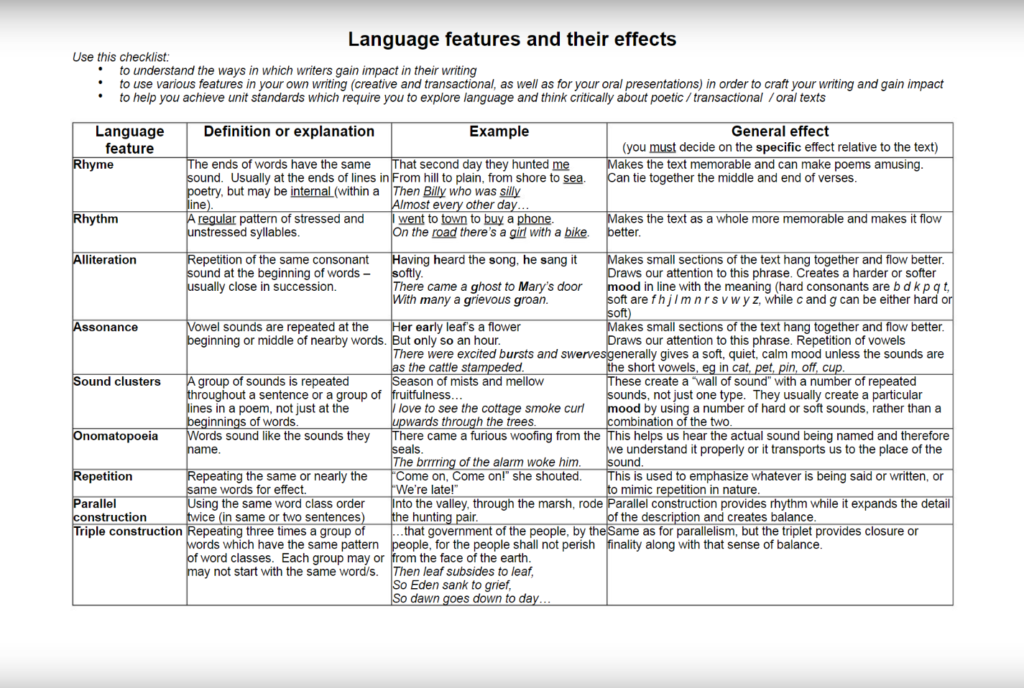
Introduction
Language is the essence of human communication, a dynamic and intricate system that shapes the way we express thoughts, emotions, and ideas. In this comprehensive guide, we will take a deep dive into the various language features that contribute to effective communication.
Whether you’re a language enthusiast, a student, or simply curious about the mechanics of language, this article will provide you with a solid foundation for understanding the key components of language. From phonology to pragmatics, we’ll explore each aspect to help you unravel the fascinating world of language features.
Explore how seeking “do my assignment” assistance complements the journey of enhancing language features.

Type of Language Features
Phonology: The Melody of Speech
At the heart of language lies phonology, the study of speech sounds and their patterns. Phonological features, including phonemes (distinctive speech sounds), intonation (pitch variations), and rhythm, give each language its unique sonic identity. Understanding phonology is crucial as it forms the basis for effective verbal communication.
Morphology: Building Blocks of Words
Morphology examines the structure and formation of words, focusing on morphemes—the smallest meaningful units. Morphological features involve prefixes, suffixes, and root words that allow us to comprehend the meanings of complex words. Delving into morphology unveils how words are constructed and evolve over time.
Syntax: Crafting Meaningful Sentences
Syntax deals with the arrangement of words to create well-formed sentences. It encompasses sentence structure, word order, and grammatical relationships. Learning syntax aids in conveying clear and coherent messages, enabling effective communication across various contexts.
Semantics: Unraveling Word Meanings
Semantics explores the meanings of words, phrases, and sentences. It delves into how words relate to one another and how context influences interpretation. By examining semantic features, we gain insights into how language conveys precise meanings and shades of expression.
Pragmatics: Language in Action
Pragmatics focuses on how language is used in context to achieve specific goals. It covers speech acts, implicature, and presupposition—essential aspects for understanding nuances and intentions behind communication. Mastery of pragmatics ensures that words align with intentions effectively.
Register and Tone: Adapting to Situations
Different contexts demand different language registers—formal, informal, technical, and more. Register involves adapting language to the social environment, while tone infuses emotion into speech. Understanding register and tone aids in tailoring communication appropriately.
Figurative Language: Adding Depth to Expression
Figurative language encompasses metaphors, similes, hyperbole, and other devices that add depth and creativity to communication. These features make language more engaging, evocative, and vivid, enhancing expression.
Idioms and Colloquialisms: Cultural Insights
Idioms and colloquialisms are expressions unique to specific languages or cultures. They carry metaphorical meanings that may not be immediately apparent to non-native speakers. Learning these features adds cultural depth to language comprehension.
Neologisms: Reflecting Change and Innovation
Neologisms are newly coined words that emerge as language evolves. They often mirror societal changes, technological advancements, and emerging trends. Staying informed about neologisms keeps your language knowledge up-to-date.
Multilingualism: Embracing Diversity
The world is a rich tapestry of languages, and multilingualism fosters cross-cultural understanding and communication. Multilingualism itself is a language feature that opens doors to diverse perspectives and enriches our global interactions.
Examples of Language Features
1. Phonological Language Features
- Phonemes and Minimal Pairs: Phonemes are distinct speech sounds that differentiate words. For example, changing the initial sound in “cat” to /b/ creates the word “bat,” illustrating the significance of phonemes in the language.
- Intonation Patterns: Rising and falling intonation can change a statement into a question or convey emphasis. “You’re coming today?” with rising intonation becomes a question.
- Rhythm and Stress: Stressed syllables in words can alter their meaning. “Rebel” as a noun is stressed on the first syllable, while as a verb, it’s stressed on the second syllable.
2. Morphological Language Features
- Inflectional Morphemes: Adding “-ed” to “walk” creates “walked,” indicating past tense. Inflectional morphemes indicate grammatical relationships without changing the core meaning.
- Derivational Morphemes: Adding “-ly” to “quick” results in “quickly,” changing the adjective to an adverb. Derivational morphemes alter both meaning and grammatical category.
- Compounding: Combining “tooth” and “brush” creates “toothbrush,” forming new words by joining existing ones.
3. Syntactic Language Features
- Sentence Structure: Sentence types like declarative, interrogative, imperative, and exclamatory have distinct structures that convey different meanings.
- Word Order Variations: In languages with flexible word orders, such as Latin, changing word order can alter emphasis without changing the core meaning.
- Clause Types: Main and subordinate clauses within complex sentences enhance expression and provide additional information.
4. Semantic Language Features
- Synonyms and Antonyms: Synonyms (words with similar meanings) and antonyms (words with opposite meanings) provide variety and clarity in language.
- Hyponyms and Hypernyms: Hyponyms are specific instances of a broader category called hypernyms. For instance, “rose” is a hyponym of the hypernym “flower.”
- Homonyms: Homonyms are words that sound alike but have different meanings, like “bat” (a flying mammal) and “bat” (sports equipment).
5. Pragmatic Language Features
- Speech Acts: Language serves functions beyond conveying information, such as making requests (“Could you pass the salt?”) or offering advice (“You should try that restaurant.”).
- Politeness Strategies: Using indirect language or modal verbs can soften requests or statements for added politeness.
- Conversational Implicature: Drawing inferences from context and conversational cues allows for efficient communication. For instance, replying “I have to work” when declining an invitation implies a genuine reason.
6. Figurative Language Features
- Metaphors: Comparing two unrelated things for poetic effect, like “time is a thief,” adds depth and imagery to language.
- Similes: Similar to metaphors, similes use “like” or “as” to compare two things, e.g., “as busy as a bee.”
- Personification: Giving human qualities to non-human entities, such as “The wind whispered through the trees,” enhances description.
7. Idiomatic Language Features
- Common Idioms: Expressions like “raining cats and dogs” have metaphorical meanings that aren’t immediately evident from the literal words.
- Proverbs: Short, wise sayings like “actions speak louder than words” offer guidance and cultural insights.
- Slang Expressions: Informal language that reflects current trends and is often unique to specific groups, enhancing connection and identity.
8. Neologisms and Emerging Language Features
- Portmanteaus: Blending two words, like “brunch” (breakfast + lunch), creates new terms for evolving concepts.
- Acronyms: Abbreviations formed from initial letters, such as “NASA” (National Aeronautics and Space Administration), simplify communication.
- Borrowed Words: Incorporating words from other languages, like “sushi” from Japanese, enriches vocabulary.
9. Multilingualism as a Language Feature
- Code-Switching: Shifting between languages within a conversation, often in multilingual communities, showcases language flexibility.
- Loanwords: Borrowing words from one language to another, like “cliché” from French, reflects cultural exchange.
- Bilingual Aphasia: A phenomenon where a bilingual individual might temporarily lose access to one language after a brain injury, highlighting the intertwined nature of language in the brain.
Conclusion
The intricacies of language features form the foundation of human communication, enabling us to express thoughts, convey emotions, and share ideas. From the musical notes of phonology to the artistry of pragmatics, each feature contributes to the symphony of language. Whether you’re a language enthusiast, a student, or someone curious about the mechanics of communication, this guide has provided you with an in-depth exploration of the various language features.
By understanding phonology, morphology, syntax, semantics, pragmatics, register, tone, figurative language, idioms, colloquialisms, neologisms, and multilingualism, you are equipped to navigate the rich landscape of language. As you continue to unravel the complexities of communication, you’ll not only enhance your linguistic skills but also appreciate the beauty and diversity of human expression.
By understanding the synergy between language features and seeking “assignment help” when needed, you’re nurturing a holistic approach to personal and academic growth.
Embark on this journey of discovery, and uncover the layers of language features that make our interactions meaningful and profound.

Leave a Reply